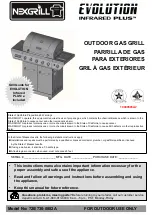
12
2. Turn all knobs to the “OFF” position.
3.
Hold an ignition source (match) at the pilot. When the flame is established, remove the ignition source.
4. Turn the burner knobs to “ON”. If the burner does not ignite, promptly open the pilot valve more. If the pilot
flame appears larger than necessary, turn it down and reset burner ignition. The pilot flame should be as
small as possible but large enough to guarantee reliable ignition of the burners when the knobs are turned
to “ON”.
Lighting main burner:
To light burner, turn knob to “ON.” Then back off to the desired flame level. The range of adjustment is virtually
infinite between “ON” and “OFF”.
Main burner air supply:
1.
For efficient burner operation, a proper balance of gas volume and primary air supply must be maintained
which will result in complete combustion. Insufficient air supply results in a yellow streaming flame. Primary
air supply is controlled by an air shutter on the front of the burner.
2. Loosen the screws on the front of the burner and adjust the air shutter to just eliminate the yellow tips of
the burner flame. Lock the air shutter in place by tightening the screws.
CAUTION: Never attempt to move a grill section while cooking. An unexpected flare could cause
severe injury. Turn off the unit, let it cool and use pot holders and/or gloves to reposition or remove.
The space between the legs at the bottom admits combustion air. DO NOT BLOCK THIS SPACE.
All burners are lit from constantly burning pilots. Turning the valve to the desired flame height is all that is
required to put the unit in service.
Do not permit fans to blow directly at the unit. Wherever possible, avoid open windows next to the units’ sides
or back. Avoid wall type fans which create air cross-currents within a room.
It is also necessary that sufficient air should be allowed to enter the room to compensate for the amount of
air removed by any ventilating system. Otherwise, a subnormal atmospheric pressure will occur, affecting
operation and causing undesirable working conditions.
A properly designed and installed hood will act as the heart of the ventilating system for the room or area in
which the unit is installed, and will leave the unit independent of changing draft conditions.
All valves must be checked and lubricated periodically. This must be done by an authorized service
representative in your area.
OPERATION INSTRUCTIONS
OPERATION:
Turn the burners on about 15-20 minutes before cooking for preheating. Set the knobs to the desired flame
height or temperature. Each valve will control the gas flow to the burner to bring that area of the unit up to the
set temperature. If different temperature settings are to be used, adjoining areas should be set at progressively
higher temperatures using the lowest temperatures on the outside burners. A uniform and systematic approach
to the loading of the unit will produce the most consistent product results.
Operation













































